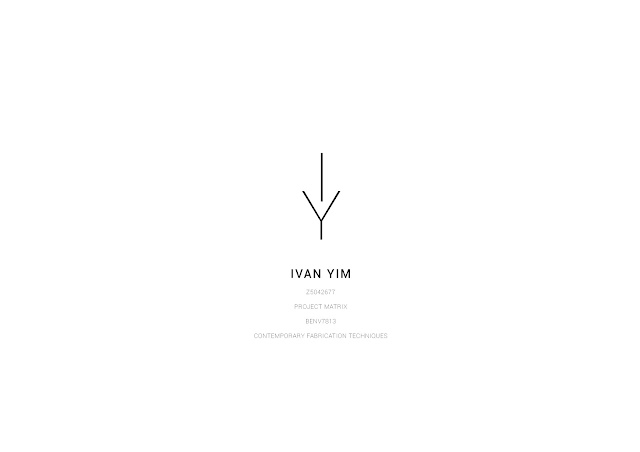Assignment 2 The Fabrications
1. Bus Stop Krumpach - Sou Fujimoto 1:25 model
Description:
This model
demonstrates a range of fabrication techniques to show the beauty of
structure and the human interaction. The colour of timber and the copper metal
rods match with each other and create a sense of abstractness and cozy
atmosphere, which in contrast perfectly with the white cold scaled people
model.
Material & Fabrication
Techniques:
Metalworking - Cut
60 pieces of long copper coating rods and 25 pieces of short copper coating
rods for soldering after.
Metalworking - Drill holes into the MPH timber block
Soldering - Solder rods together with the short rods, with the media- "Baker Soldering Fluid".
Woodworking - Trim and cut the MPH hardwood for the base by thicknesser and bandsaw
Woodworking - Sanding the base surface with sand paper
Woodworking - Polishing the base with orange oil
Laser-cutting - Cutting Bamboo stairs and 3mm white acrylic 1:25 scaled models
1.1 Front elevation showing the human interaction. A fascinate contrast with the cool white human and warm brown timber and copper coating rods.
1.2 Photography illustrating closeup different human interactions.
1.3 Photography showing the main staircase and how human walking up the stairs.
1.4 Closeup view taking from bottom to above showing how is the staircase joining with copper coating rods.
1.5 Video illustrating how the light casts the shadow on the bus stop model.
2. House OM- Sou Fujimoto 1:50 model
Description:
This model is challenging and it definitely shows the ambition of this assignment. 80 % of the model is casted by cement with only 6mm thickness walls and slabs. It demonstrates a really high accuracy and focus of making this model, as it is extremely fragile. In addition, the delicacy of front cement facade with detailed bolts and hatch line, which is done by laser-cut engraving mold. As the result, it shows the reality feeling of the building and shows a kinds of aesthetic of architecture.
Hot-wiring - Cutting foam for the basement void space
Molding - The use of "release agent" to prevent the cement sticking into the mold
Gluing - Hot glue and super glue are necessary for sealing the edge to prevent the cement leaking out during casting
Laser-cutting - Cutting the 4.5 mm Acrylic plates for molding + 1:50 scaled people + furniture
Material & Fabrication Techniques:
Casting - 6mm cement of 3 slabs + 1 detailed front wall + 2 side walls + basement
Hot-wiring - Cutting foam for the basement void space
Molding - The use of "release agent" to prevent the cement sticking into the mold
Gluing - Hot glue and super glue are necessary for sealing the edge to prevent the cement leaking out during casting
Laser-cutting - Cutting the 4.5 mm Acrylic plates for molding + 1:50 scaled people + furniture
Sanding - Sanding the base to have a polish feeling
3D printing - 3D printing 4 internal curve walls + 2 stairs case
2.1 Front elevation showing the human interaction. A brilliant light captured on the cool cement facade and car park in the basement.
2.2 Perspective view showing the front and side facade.
2.3 Photography capturing the top view of the hollow spaces.
2.4 Side elevation capturing the 3 floors.

2.5 Three photos in the same sequence scenes capturing in the ground floor.
2.6 Photography capturing the light casting on specific space.
2.7 Videos capturing how the light casting through the transition of time.
2.8 Behind the scene : Laser-cutting mold showing the details of the bolts and hatch lines
3. LA Small House - Sou Fujimoto 1:1 model
Description:
This model demonstrates the casting skills and molding skills. It looks simple but unexpectedly hard to control the time, ratio and bubbles. There are 2 attempts of making this model. The first attempt model was fail, as the outdoor temperature was too cold and in fact, the mixture was not fully blended together. the resin looked liquefied and its not dry even it had already taken 1 week. The second attempt model has paid more attention on unstable factors such as room temperature, air from the rocks and time. "Depressor" has been used for degassing the bubbles from the resin and rocks. The result has been improved compared to the first attempt,but still bubbles trapped into the model.
Material & Fabrication Techniques:Casting - Resin
Molding - 4.5 mm acrylic plate is used for molding
Gluing - Hot glue and super glue are necessary for sealing the edge to prevent the cement leaking out during casting
Laser-cutting - Cutting the mold for casting
Spray Painting - Painting the natural rocks from black to white colour
3.1 Top view model lighting up by light box. (Left : Front , Right : Rear)
3.2 Closeup view expressing how human living with random rock structure space.
3.3 Closeup rear view showing a rough rock surface and a sense of natural feeling.
3.4 Behind the scene: using the light pad to capture the atmosphere.
3.5 Behind the scene: First attempt fail model (top) and test piece resin model (bottom)


























Comments
Post a Comment